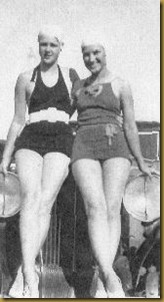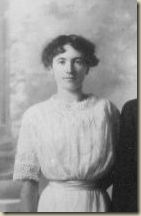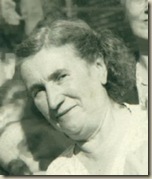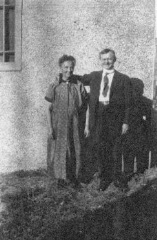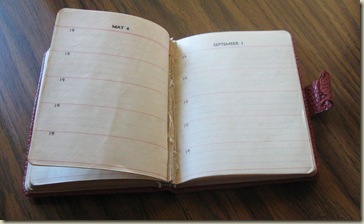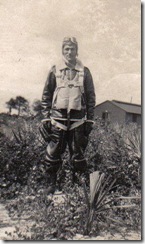
Tuesday, February 19, 2013
When Opportunity Knocks, You Have to Open the Window
Wednesday, June 6, 2012
Friday, May 4, 2012
Wednesday, March 21, 2012
Wednesday, March 7, 2012
Monday, January 9, 2012
Military Monday–Hoping for a Homecoming, Part 2
In one of his very informative emails, David sent the link to the Defense Prisoner of War * Missing Personnel Office’s website. This office is actively working to identify remains, and it’s never too late, as this very recent press release regarding Staff Sgt. John J. Bono demonstrates. Staff Sgt. Bono was on a plane that crashed on September 13, 1944 in Germany. It took a very, very long time, but this soldier has finally come home.
One of the methods used for identifying remains involves mitochondrial DNA. Unlike Y-DNA used for genealogical purposes, mitochrondria DNA (mtDNA) cannot prove relationship to any high degree, but it can exclude relationship, or can provide supporting evidence of a relationship. Furthermore, rather than requiring a sample from the direct-line males in the family, mitochondrial DNA may be supplied from other near relatives. In the case of an unaccounted-for male soldier, either a brother, a sister, or the sister’s descendants to the third generation may supply DNA for testing.
The Central Identification Laboratory does the work of putting together the evidence with the goal of making an identification. Using data surrounding the recovery of the remains, race, age, height, medical and dental records, fingerprints, and DNA, sometimes a presumptive identification can be made.
Without delay, I contacted the Central Identification Laboratory (CIL), and settled down for what I was expecting to be a long wait. Within the week, I received a phone call from an agent at the CIL requesting more information, and explaining the process to me. He sent, by Federal Express, two mtDNA collection kits, one for myself, and one for my mother, direct descendants of Ray’s sister Lillian. The kits consisted of swabs that we used on the insides of our cheeks to collect cells. We packaged these swabs for return to the lab. In addition, we were asked if we had envelopes from any of Ray’s letters home; the process of licking the envelopes to seal them would be his contribution to the process. We had two, which we sent. We were assured that they would be returned. The process was very quick, and very simple, and return Fed-Ex fees were paid by the laboratory.
And now, we wait. We understand that this process will not be a quick one, and no results can be guaranteed, but we’re grateful for the opportunity to at least try, thanks to David. I’m hoping that 2012 will be the year Raymond Christensen finally comes home.
Monday, January 2, 2012
Military Monday–Hoping for a Homecoming, Part I
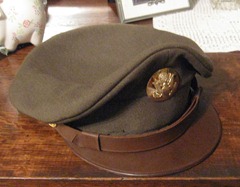 My correspondent, David, who is a collector of military items and a veteran himself, had read my blog post regarding my uncle Raymond, who, along with his pilot Joseph Leonard, were lost when their plane went crashing down into the Tyrrhenian Sea near Montecristo late on the night of May 13, 1944. David had found a soldier’s cap with the name Lt. Joseph E. Leonard on it, and was doing some internet research to learn more about this fallen hero. We exchanged information – I had information on Ray, including a Missing Air Crew Report, and he had expertise on all things military, and so our conversations began.
My correspondent, David, who is a collector of military items and a veteran himself, had read my blog post regarding my uncle Raymond, who, along with his pilot Joseph Leonard, were lost when their plane went crashing down into the Tyrrhenian Sea near Montecristo late on the night of May 13, 1944. David had found a soldier’s cap with the name Lt. Joseph E. Leonard on it, and was doing some internet research to learn more about this fallen hero. We exchanged information – I had information on Ray, including a Missing Air Crew Report, and he had expertise on all things military, and so our conversations began.Since our family was notified of Raymond’s status back in 1944, little has changed. The last we heard, the crew of the Bristol Beaufighter KW 161 was missing and unaccounted for. All that remained at the site of the wreckage was “much debris, an oil slick, and two life rafts.” End of story.
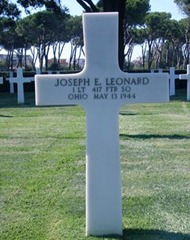
It was during these exchanges when David told me that Lt. Joseph Leonard was buried at the Sicily Rome American Cemetery in Nettuno, Italy: Plot H, Row 9, Grave 40. What? Raymond Christensen was not buried there, nor was he listed among any of the other identified soldiers in overseas cemeteries. Both men went down in the same location at the same time. One was recovered. One was not?
David’s words eventually sunk in: He was telling me there may be a possibility that Raymond’s remains were not lost, but unidentified. Dog tags, David explained to me, were typically the only means of identifying remains, and if Raymond had lost his dog tags in the events of that night, he may have been recovered but not identified.
More to come.
Wednesday, May 25, 2011
Bathing Beauties
My grandfather, Bill Knutz, found himself a couple of special “hood ornaments” on one hot and sunny summer day in eastern South Dakota – his future wife, Lillian Christensen (right), and her cousin Ruth. This photo, taken in 1935, depicts a common scene at the farm of his parents, Will and Virta Knutz, where their teenage children would stop up the creek to make a “swimming hole,” which was popular with all of the young people in the area.
Thursday, March 10, 2011
Adventures in Gardena
“I suppose Mother told you about our bad luck with the car, but I know she really didn’t know how it happened so I’ll tell you, ha ha. We went out to Silver Lake, that is where my sister Katrine is living. We stayed there all night as we didn’t have our gas and electricity turned on. So in the morning we went out to our car, it was parked on a hillside, almost a mountain. The brake alone would stop it from going down hill so I left it in low gear. You know it was foggy in the evening so the windshield was clouded over. I got a rag and started to clean it off. Mother climbed in the car. And first thing I knew the car started down hill, very slowly at first. She tried to get out but was afraid to let go of the car. There she was half out and half in, and I had to pull hard on her to make her let go. It’s a wonder she did not get hurt. You know when she got in the car she pushed the lever with her legs and got it out of gear. Next time I’m going to leave it in reverse. The car went across the street and dropped about 10 ft then over another garage and a drop almost straight down of about 20 ft and landed up against a house. It made a big dent in the wall of the house. I’m glad it was not a brick wall. The car never even turned over. A Ford can really take it. Estimated damage to car $180.00 The man who owns the house claims damage to house and lot $3000. A darn good thing I had insurance, don’t you think? It cost $25 to get the car hoisted up to the street again with a crane and 2 trucks. I was able to run the car after it was pulled up. It had one crumpled fender, two damaged running boards, 3 broken windows, broken grill and bent bumper. I’m sure it could never do that again, and be able to run.”
He went on to describe “city driving”:
“You should try to drive a car in San Diego or Los Angeles. They pass you on both sides and if you have to make a right or left turn, and aren’t in the right place it’s just too bad. They are smashing cars every day. I don’t want a new car for awhile. “
Friday, January 28, 2011
Forebear Friday – Ella Monsen Christensen
Gabriella Alfhilde Monsen looks like just a wisp of a girl, but she must have been tough. Born in Bergen, Norway in 1884, Ella was the daughter of Gabriel Monsen and his wife Alvilda Marie Olsen. Her father, a fisherman by trade, was caught in a violent storm off the coast of Norway when Ella was about 7, and vanished. After the death of her father, the family lived in a small apartment in Bergen, her mother taking in washing to put food on the table. By the time Ella was 16, she was helping to support her family by working as a domestic servant.
In April of 1904, at the age of 20, Ella boarded a ship destined for the United States, to the home of her paternal uncle Rasmus “Rob” Sandene in Miner County, South Dakota. She would never return to her home country again. “Uncle Rob”, who had himself left Norway in 1887, helped the new immigrants of the family, one by one, to acclimate to their new culture. It was there that Ella learned English, and then again forged out on her own, taking a job as a domestic servant in Huron, about 60 miles away. In the next five years, her brother and sister also left Norway. Alvilda did not join her children here until 1915.
Ella married Peter C. Christensen, a Danish immigrant who owned Bell Bakery, in May of 1911. They also spent time farming in rural Beadle County. She was a farm wife who raised five children – Lillian, Raymond, Clarence, Edna and Sylvia, and later helped to raise Lillian’s children, who lived on a farm just down the road. Her granddaughter Betty has some very fond memories of her, and what a fun grandmother she was. She was nice to everyone, but she was also stern.
In 1947, they sold their farm in Beadle county and left behind the hard work and brutal winters. They retired to a lovely home with a park-like corner lot in Gardena, California, where they enjoyed fruit trees and a koi pond. Their children Clarence and Sylvia married and raised families there as well. She was just 67 when she died at her home of heart failure five years later. She is buried at Roosevelt Memorial Park Cemetery.
Wednesday, September 8, 2010
The Needle in the Haystack – Finding Elsie in the Census
I’ve been looking for the family of my great-grandfather, Peter Christensen of Denmark, for some time. I’ve looked for them in the census before, but when you’re working with “heresay” information, and names as common as Christensen and Ericksen, in an area thick with Danish immigrants, it gets overwhelming quickly. I knew the first names of his brothers and sisters, knew his mother’s name was Elsie, and many of the men in his family were bakers. I had heard his father died in Denmark, and Elsie remarried a Mr. Erickson/Ericksen/Eriksen/Erikson etc., and probably lived in Omaha or Council Bluffs, Iowa, or Onawa, Iowa.
2) “Mr. Ericksen” now has a name – Gents Ericksen.
3) Gents was 11 years younger than his wife – probably not a terribly important piece of news, but kind of interesting nonetheless. I may never find out, but I’d love to know their story.
4) I have a location and birth years for Elsie’s children Soren and Martin. Another thing I discovered on the path to the 1920 census was a married name for Elsie’s daughter Mary, an address in Omaha, a date of death, and a relocation to California.
Now it’s really time to get busy – I have an obituary for son Soren coming, and will get one for daughter Mary; I need to find a date of death for son Martin, as well as Elsie and Gents, and try to get obituaries for them as well in hopes of going back another generation. Now that I know Gents’ name, and their birth years, I can attack the censuses once again, and differentiate them from all of the other Ericksens. Gents and Elsie, as well as Soren, are listed in the census as being naturalized – I need to get those papers. Soren and Martin were bakers, and I’d like to go through the city directories and get more information on where, specifically, they worked. Did they own their own bakery, as their brother Pete (my great-grandfather) did in South Dakota? If so, what was the name, and where was it located? I feel a trip to Omaha coming on!
One very important piece of information has eluded me so far – I’d like to know the name of Elsie’s first husband, my great-great grandfather. I am hoping it will show up in one of the obituaries. If so, I’ll be learning how to do Danish research – a task I thought I’d never need to know. It’s been a long time since I’ve heard the crumbling of a brick wall, and it sounds wonderful!
Wednesday, September 1, 2010
Saturday, August 28, 2010
Saturday Night Genealogy Fun
This is the first time I’ve been able to participate in SNGF – and it IS fun! Thanks to Randy Seaver (and Sheri Fenley) for the terrific prompt.
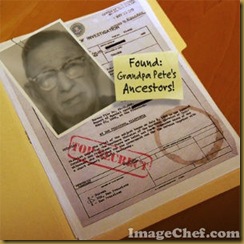
Randy’s instructions:
1) Go to the www.ImageChef.com website and explore their FREE offerings. Click on the "Create" button, or choose to make a slideshow or posters from their main page
2) Make one or more posters or other creation - perhaps they relate to genealogy or your own family history. Save them to your computer
3) Show your creations to us...
So here’s mine! Hopefully this will be a reality some day, and Peter Christensen’s ancestors will be found!
Saturday, March 27, 2010
Ray
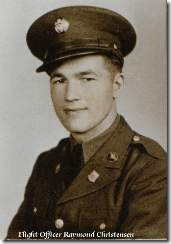
I never met Flight Officer Raymond Christensen personally, but I’ve heard so much about him over the years that it’s hard not to feel close to him. He was my grandfather’s best friend, and my grandmother’s younger brother, although my grandmother never talked about him much. A gifted writer, with devilish good looks, and a sense of adventure, combined with a charming wit all equipped him to make a success of himself in his various undertakings. His life, had it been longer, would have made an incredibly fascinating book.
Growing up in rural Beadle county, South Dakota, my grandparents and their siblings and friends “made their own fun.” They stopped up Cain Creek and made a popular “swimming
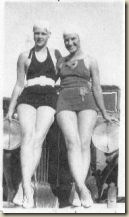 hole”, and occasionally took my grandfather’s old Model A on a road trip. Ray and my grandmother, being less than two years apart, were naturally very close. She was his trusted confidante, and vice versa. But it was his friendship with my grandfather, Bill, that brought out the fun-loving sides of both of them. Bill told how they went to the river and caught snapping turtles, and when they had several of them, they daringly positioned the tail of one in the mouth of another, and so on, until they had a Wagon Train of snappers, all “snapped” together. They then, very carefully, got the first snapper to bite onto a cigarette and clench it between his jagged, razor teeth long enough for a picture to be taken. They learned new and creative ways to shock each other with the aid of an old magneto, an object that kept the boys occupied off and on for years. No one ever truly knew what was safe to sit on, pick up, or even touch with Bill and Ray and that magneto around.
hole”, and occasionally took my grandfather’s old Model A on a road trip. Ray and my grandmother, being less than two years apart, were naturally very close. She was his trusted confidante, and vice versa. But it was his friendship with my grandfather, Bill, that brought out the fun-loving sides of both of them. Bill told how they went to the river and caught snapping turtles, and when they had several of them, they daringly positioned the tail of one in the mouth of another, and so on, until they had a Wagon Train of snappers, all “snapped” together. They then, very carefully, got the first snapper to bite onto a cigarette and clench it between his jagged, razor teeth long enough for a picture to be taken. They learned new and creative ways to shock each other with the aid of an old magneto, an object that kept the boys occupied off and on for years. No one ever truly knew what was safe to sit on, pick up, or even touch with Bill and Ray and that magneto around.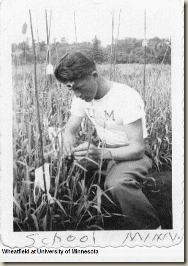
After high school, Ray worked as a farm hand in various midwest locations, until deciding he’d like to go to Agriculture school at the University of Minnesota, a decision that fiercely angered his father. Going it alone, Ray sold life insurance for State Farm in Minneapolis to support himself and pay his tuition. He was the first in his family to pursue higher education. The photo on the left shows him grafting a hybrid wheat plant in the University’s wheat field. His “smarts”, as well as his determination, and his desire for something “bigger”, would have taken him far in the field of agriculture, had he gotten the chance.
World War II altered the course of many lives, and Raymond’s was no exception. After three years of study at the University, he put his agriculture degree on hold and was accepted in an officer’s training school in the Army Air Force. A letter to my grandparents, dated Feb. 20, 1942, reads in part:
“Started to school Saturday and like it O.K. It will come fast but if they keep me in like they have in the past I’ll not only get it, but get fat too. (The) Grub is swell … I’m learning typing – code – electricity and eventually radios. If I pass I may get to be radio man on a bomber and fly all over heck…”
And that’s exactly what happened. After completion of his program, he was assigned to the 417th Night Fighter Squadron as a radar observer with the rank of First Lieutenant. He was one of a crew of two in an English Beaufighter, working with pilot Joseph Leonard. Ray described the relationship between them as such -
“I’ve got quite a bit of faith in my pilot and we get along as well as anybody could … We’ve got to have perfect teamwork to live out this blessed war so we pay as much attention in our teaming up as we would to getting married - probably more. In this case “until death do us part” doesn’t seem to lend any humor to the situation whatever.”
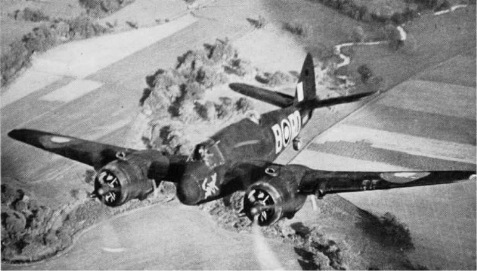
Letters continued to go back and forth between Ray and my grandparents. A letter from Ray, dated May 5, 1944, describes the dangerous situations they faced on the island of Corsica, where Ray was stationed:
“When we go airborne we can look right into Herr Hitler’s back yard and make faces at him. One of his little boys done foxed me the other night so here I sit on the end of the runway just awaitin’ to get revenge…”
This would be the last letter my grandparents got from Ray. Eight days later, he and Joe flew what would be their last mission. The plane was located at the point of the red “X” on the map below, when it was last seen on radar, shortly before going down under enemy fire. Six planes were sent in a search and rescue attempt, joined by six more in the early hours of May 14, my grandmother’s birthday. All they found was “much debris, an oil slick, and two life rafts.”
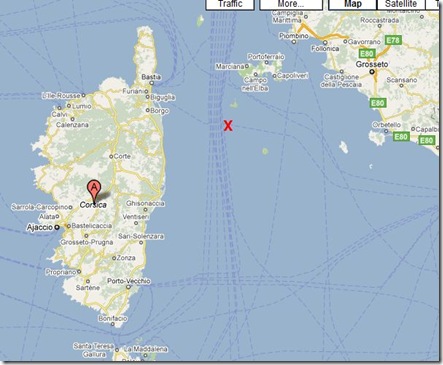
Ray was posthumously awarded the Purple Heart and Air Medal for his courage and sacrifice. And that’s the end of his story. But my mind can’t help but wander, and entertain the notion of what he might have done had he lived a full measure of years. He took life by the horns, and he had some incredible gifts that will go forever unused. We’re left to wonder What If…
Sunday, February 7, 2010
Happy Valentine's Day - A Corny Valentine
Friday, November 13, 2009
And So It Goes... Mothers and Daughters
Alfhilde Olsen Monsen, widow of Gabriel Monsen, with her baby daughter Gabriella (later known as "Ella"), this photo was taken about 1885 in Bergen, Norway. Her husband, a sailor, died at sea in a boating accident, leaving her with three small children.
Ella Monsen Christensen immigrated to the United States from Norway at the age of 20, learned English, and worked as a houshold servant. She later sent for her mother and siblings. She married Peter Christensen, a baker, in Huron, South Dakota. She is pictured here with her daughter, Lillian, about 1912.
Lillian and her first child, daughter Betty, on their farm in Beadle county, South Dakota, about 1939.
Betty, with her first daughter, Karen (me!), about 1959.
Friday, May 22, 2009
Memorial Day
 Delbert Dee Graves, 1891 - 1918, died in World War I, in France. He was the only son of Thomas and Nettie Graves. He joined the American Expeditionary Forces (aka "Doughboys") on June 27, 1918, and was assigned to Co. H of the 351st Infantry. After training, he was sent overseas to England on Aug. 28, 1918, and then to France shortly afterward. He worked in difficult circumstances, cold and damp, and his mother would knit him sweaters because he just could not keep warm enough in his surroundings. As a result he contracted an illness which led to scarlet fever, and died in a makeshift military hospital in France. He was buried in France, but a few years later was brought home to a hero's welcome in his small town of Carthage, South Dakota, and buried in Pleasant View Cemetery. The American Legion Post in Carthage was named in honor of him. Delbert was my great-grandmother's younger brother; he had worked as a drayman, carpenter and farmer, in conjunction with his father, and enjoyed raising hounds.
Delbert Dee Graves, 1891 - 1918, died in World War I, in France. He was the only son of Thomas and Nettie Graves. He joined the American Expeditionary Forces (aka "Doughboys") on June 27, 1918, and was assigned to Co. H of the 351st Infantry. After training, he was sent overseas to England on Aug. 28, 1918, and then to France shortly afterward. He worked in difficult circumstances, cold and damp, and his mother would knit him sweaters because he just could not keep warm enough in his surroundings. As a result he contracted an illness which led to scarlet fever, and died in a makeshift military hospital in France. He was buried in France, but a few years later was brought home to a hero's welcome in his small town of Carthage, South Dakota, and buried in Pleasant View Cemetery. The American Legion Post in Carthage was named in honor of him. Delbert was my great-grandmother's younger brother; he had worked as a drayman, carpenter and farmer, in conjunction with his father, and enjoyed raising hounds. Raymond Christensen, 1914 - 1944, was killed in action in World War II. He interrupted his education at the University of Minnesota to enlist, and enrolled in officers training school in Florida. He was a flight officer in the 417th Night Fighter Squadron. He was one of a crew of two in an English Beau Fighter, and flew some of the most dangerous missions in the war. He was initially listed as Missing in Action, but his status was later changed to Killed in Action over Sicily, on May 13, 1944. He is still remembered for his wit and humor. He sold insurance policies while he put himself through school at the University of Minnesota and the St. Paul Agricultural College. He was a masterful practical joker. He was my grandmother's younger brother, and my grandfather's best friend.
Raymond Christensen, 1914 - 1944, was killed in action in World War II. He interrupted his education at the University of Minnesota to enlist, and enrolled in officers training school in Florida. He was a flight officer in the 417th Night Fighter Squadron. He was one of a crew of two in an English Beau Fighter, and flew some of the most dangerous missions in the war. He was initially listed as Missing in Action, but his status was later changed to Killed in Action over Sicily, on May 13, 1944. He is still remembered for his wit and humor. He sold insurance policies while he put himself through school at the University of Minnesota and the St. Paul Agricultural College. He was a masterful practical joker. He was my grandmother's younger brother, and my grandfather's best friend.Delbert and Raymond's families bore tremendous pain and long-lasting implications at the loss of their sons/brothers, as do the families of all fallen soldiers. It's so easy to forget that this holiday is more than a three-day weekend, filled with camping, fishing, cookouts, etc. It's a day to remember and honor these men, and their families who paid a huge price for all we enjoy in the U. S. today. Take some time to remember all of them with gratitude.







